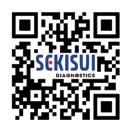

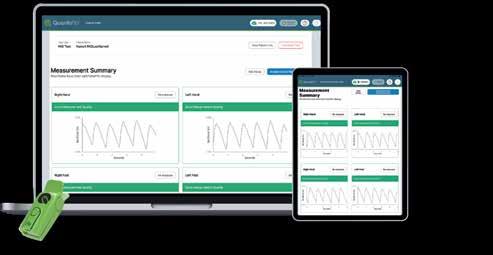














There are two simple ways to request information about the products and services found in Physicians Office Resource.
1. Go to www.PhysiciansOfficeResource.com and enter the four-digit reference number found next to the product or service into the search field, then request additional information, schedule a demo, or speak with a sales agent all with just a simple click of a button.
2. Find the Business Reply Card in this issue, circle the desired reference numbers, complete the form, and drop into any USPS mailbox. A representative will contact you as quickly as possible to answer your questions.
PUBLISHED BY Medical Education Resources, LLC
PUBLISHER
Aaron R. Medaris amedaris@physiciansofficeresource.com
CEO
Andrew C. Nimmo acnimmo@physiciansofficeresource.com
PRESIDENT
John D. Pasquale jpasquale@pharmaconnect.com
BUSINESS MANAGER
Marci J. Hills mhills@physiciansofficeresource.com
TRAVEL EDITOR
Brandi L. Brower
EDITORIAL BOARD
Shakeel Ahmed, MD
Barry Craig, MLT (NCA), CLC
STAFF WRITER
Dylan J. Chadwick
CREATIVE DIRECTOR PRODUCTION MANAGER
Jessica Elmer
Copyright ©2025
To continue your free subscription of Physicians Office Resource magazine, please fill out the Business Reply Card (BRC) located within this magazine and drop in any United States Post Office mailbox.
If you are a manufacturer of medical products or provide services to medical professionals and would like to advertise your products or services to the nation’s top physicians doing in-office testing, call 801-380-6094 or visit: POR.io for more information.

The Metrix® COVID/Flu Test is a highly accurate molecular test with a small footprint and a seamless testing procedure that can accurately detect and differentiate between SARS-CoV-2, Flu A, and Flu B at the point-of-care.
The platform requires minimal hands-on time with no need for calibration or maintenance, significantly enhancing workflow efficiency for healthcare professionals.
Use this simple, efficient, and affordable multiplex molecular testing solution to deliver lab-quality results in 20 minutes ANYWHERE and EVERYWHERE
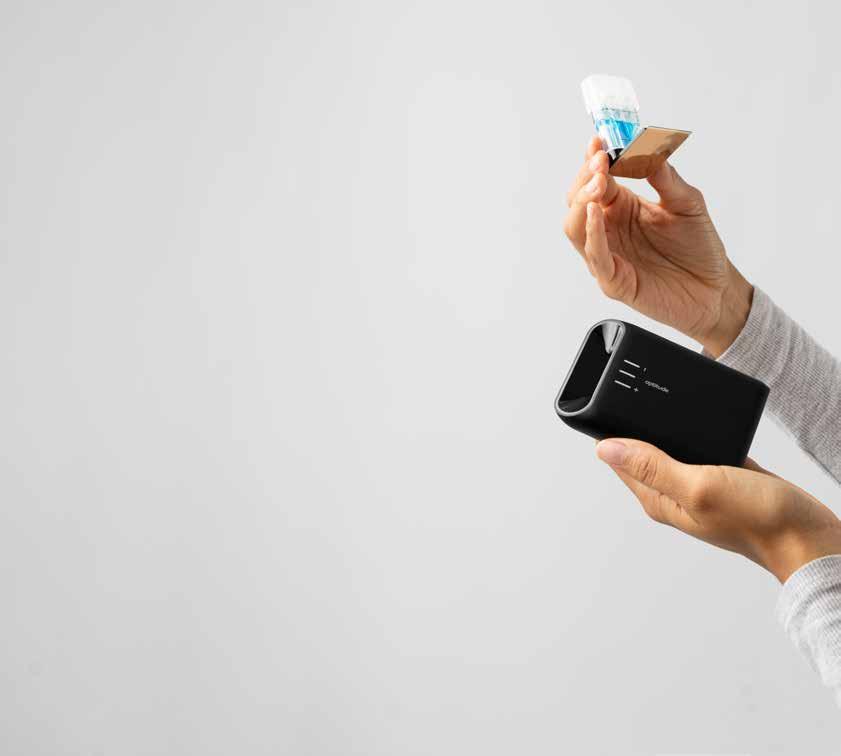
Breast cancer remains the most common cancer diagnosed in women worldwide and the second leading cause of cancer-related death in women in the United States.
Despite advances in diagnostics and therapeutics, the backbone of health care—frontline employees— strains under workloads, staffing shortages, and limited career opportunities.

Preparing for the Respiratory Illness Season
In 2025, the convergence of influenza, COVID-19, RSV, and other viral pathogens is expected to once again increase patient load, stretch staff capacity, and test the preparedness of outpatient clinics.
Better outcomes. Lower costs. Better patient experience. Better clinician experience.

Gain insights into your patient’s current status with real-time actionable results.
DCA Vantage® Analyzer
Rapid assessment of glycemic control and kidney health
HbA1c
• CLIA-waived
Albumin-to-creatinine ratio (ACR)
• CLIA Moderate Complexity
CLINITEK Status® Connect System
CLIA-waived analyzer for routine urinalysis, including kidney health
• CLINITEK® Microalbumin 2 Strip (ACR)

Customize your patient consultations to enhance physician-patient partnership toward improved outcomes.


BY ADAM IRVINE, PHYSICIANS OFFICE RESOURCE
Breast cancer remains the most common cancer diagnosed in women worldwide and the second leading cause of cancer-related death in women in the United States. With an estimated lifetime risk of about 1 in 8, nearly every primary care physician (PCP) will care for multiple patients affected by breast cancer, whether through screening, risk reduction, early recognition, or survivorship care. Although oncologists and breast specialists ultimately guide treatment, the role of the PCP is central in prevention, detection, long-term monitoring, and patient education.
This article provides an updated overview of what every primary care physician should know about breast cancer, including practical screening strategies, red flag symptoms, genetic risk identification, survivorship management, and preventive counseling. The goal is to empower PCPs with structured, actionable approaches that can be applied in daily practice.
Breast cancer accounts for approximately 30% of all new cancer diagnoses in women. While incidence increases with age, it is important to remember that younger women, though less frequently affected, often present with more aggressive subtypes. Men represent less than 1% of all breast cancer cases, but awareness of this possibility is crucial, especially in high-risk families.
PCPs should be able to distinguish non-modifiable from modifiable risk factors:
Non-modifiable:
• Increasing age (risk accelerates after age 50)
• Female sex
• Family history of breast, ovarian, pancreatic, or prostate cancer
• BRCA1/2 mutations and other genetic syndromes (e.g., TP53, PTEN, CHEK2)
• Dense breast tissue on mammography
• Reproductive factors: early menarche, late menopause, nulliparity, late age at first birth
• Prior chest radiation (especially in childhood cancer survivors)
Modifiable:
• Obesity and weight gain after menopause
• Alcohol use (risk increases in dose-dependent fashion)
• Smoking
• Sedentary lifestyle
• Prolonged hormone replacement therapy (HRT)
For primary care, risk assessment should be a routine part of preventive visits, updated annually to capture new family history or lifestyle changes.
Breast cancer screening recommendations vary slightly among organizations, but consensus is forming around earlier initiation:
• USPSTF (2024 update): Biennial mammography starting at age 40 and continuing through age 74.
• American Cancer Society (ACS): Annual mammography beginning at 45, with the option to start at 40. After 55, every 1–2 years.
• ACOG: Annual mammography starting at 40.
Practical tip: PCPs should offer shared decision-making beginning at age 40 and tailor frequency based on risk factors.
For women at significantly elevated risk (≥20% lifetime risk, BRCA carriers, strong family history, prior chest irradiation), guidelines recommend:
• Annual breast MRI + mammogram beginning at age 30.
• Consider earlier screening if a family member was diagnosed at a very young age.
Routine clinical breast exams are no longer universally recommended for asymptomatic women, but remain reasonable in the context of symptom evaluation or high-risk patients. Encouraging “breast self-awareness” rather than rigid monthly self-exams is increasingly favored—patients should know what is normal for their own breasts and report any changes promptly.
Although most breast complaints prove benign, PCPs must remain vigilant for suspicious features. Key red flags include:
• A firm, irregular, immobile breast mass
• Spontaneous, unilateral, bloody nipple discharge
• Nipple retraction, skin dimpling, or “peau d’orange” changes
• New asymmetry or unexplained persistent breast pain
• Axillary lymphadenopathy
Evaluation strategy:
• <30 years: Begin with breast ultrasound.
• ≥30 years: Diagnostic mammogram plus targeted ultrasound.
• If imaging is suspicious, proceed to core needle biopsy and refer to a breast specialist.
Timely recognition and referral are critical—delays in diagnosis remain one of the leading contributors to worse outcomes.
Primary care physicians are often the first to recognize when a patient may benefit from genetic evaluation. Consider referral for genetic counseling/testing if any of the following apply:
• Two or more first-degree relatives with breast or ovarian cancer
• Breast cancer diagnosed in a relative before age 50
• Male breast cancer in the family
• Known familial BRCA mutation
• Triple-negative breast cancer diagnosed before age 60
• Personal or family history of multiple related cancers (ovarian, pancreatic, prostate)
PCPs should not feel pressured to manage genetic testing independently. Instead, their role is to recognize high-risk individuals and facilitate timely referral to genetics specialists.
Survivorship Care in Primary Care
Thanks to advances in treatment, there are over 4 million breast cancer survivors in the U.S. today. Once active oncology treatment concludes, many patients transition back to primary care for long-term follow-up. PCPs should be comfortable managing:
Surveillance
• Annual mammography of remaining breast tissue.
• Clinical visits every 3–6 months for the first 3 years, then annually (in collaboration with oncology).
• Attention to new symptoms that may signal recurrence: persistent bone pain, weight loss, neurologic changes, cough, or dyspnea.
Treatment-Related Complications
• Cardiotoxicity: Monitor cardiac function in patients with prior anthracycline or trastuzumab exposure.
• Osteoporosis: Aromatase inhibitors accelerate bone loss; ensure regular DEXA screening and appropriate supplementation.
• Menopausal symptoms: Hot flashes, vaginal dryness, and fertility challenges may require supportive management.
• Lymphedema: Educate on early recognition and preventive strategies.
Psychosocial Concerns
Depression, anxiety, body image concerns, and sexual dysfunction are common yet underrecognized. PCPs should screen proactively and refer for counseling, support groups, or sexual health therapy as needed.
Prevention and Risk Reduction in Primary Care
Even small lifestyle changes can lower breast cancer risk. PCPs should emphasize:
• Exercise: At least 150 minutes of moderate-intensity activity weekly.
• Weight control: Particularly important after menopause.
• Alcohol moderation: Ideally <1 drink per day.
• Smoking cessation: Both direct and indirect risk reduction.
• Diet: Increased intake of fruits, vegetables, fiber; reduced processed foods.
For very high-risk women, chemoprevention may be appropriate. Tamoxifen, raloxifene, or aromatase inhibitors reduce breast cancer risk in carefully selected populations. PCPs should initiate the conversation but typically refer to oncology for shared decision-making.
Prophylactic surgery, including bilateral mastectomy or oophorectomy, may be lifesaving for BRCA carriers. These discussions should occur in partnership with breast specialists and genetic counselors.
Disparities in breast cancer outcomes remain stark: Black women are diagnosed at similar rates as White women but are 40% more likely to die of the disease. Contributing factors include later-stage diagnosis, lower access to timely care, and more aggressive tumor biology.
Primary care physicians play a critical role in addressing these disparities by:
• Ensuring universal access to screening in underserved populations.
• Proactively following up on abnormal screening results.
• Advocating for culturally competent patient education and support.
At-a-Glance
• Risk assessment performed at preventive visits
• Family history updated annually
• Screening mammography ordered at appropriate interval
• High-risk patient referred for genetics/early MRI
• Patient educated about breast self-awareness
• Survivorship care plan documented (if relevant)
• Lifestyle counseling provided
1. Age <40: Screen only if high risk → refer to genetics/imaging.
2. Age 40–74: Mammogram every 1–2 years.
3. High-risk (BRCA, strong family history, prior radiation): Start MRI + mammogram at 30.
4. >75 years: Individualized decision-making based on health status and life expectancy.
Conclusion
For primary care physicians, breast cancer management extends far beyond simply ordering mammograms. The PCP’s role encompasses risk assessment, early recognition of red flags, genetic counseling referral, survivorship care, and preventive counseling. Equally important is the responsibility to address disparities in care and ensure that every patient—regardless of background—has access to timely, evidence-based prevention and treatment.
By incorporating structured checklists, clear screening algorithms, and patient-friendly education, PCPs can significantly impact breast cancer outcomes. Ultimately, the partnership between primary care and oncology is essential to reducing the burden of this disease and improving both survival and quality of life for patients.


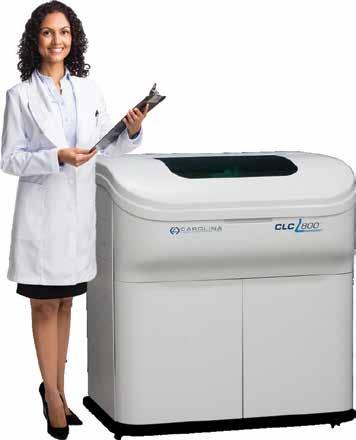
from
Your Patients Trust YOU To Find Their Peripheral Artery Disease
• High-risk patients include those over 65, diabetics, and smokers.
• If left untreated, 25% of patients with PAD will experience a heart attack or stroke within 5 years.
• PAD symptoms are often mistaken for arthritis or old age.
The simpleABI Cuff-Link System is Easy to Learn and Use.
• With a push-button remote, automatic calculations, and waveforms, it’s incredibly user-friendly.
• Reports are straightforward to save and share since the system is PC-based.
Outstanding Value and Reimbursements
• The system pays for itself in less than a year with just one test per week.
• Medicare reimbursements vary by exam and location, averaging from $91 to $174.
From Bindex Medical
Comparable to DXA
Extensive clinical research has proven Bindex to be 90% accurate in detecting osteoporosis. It can replace nearly 70% of DXA scans for patients with suspected osteoporosis.
Fast and effective
Using safe pulse-echo ultrasound to measure cortical bone thickness, Bindex analyzes bone density in just seconds.
Easy to use anywhere
Lightweight and pocket-sized, Bindex allows patients to receive on-the-spot bone density scans in doctors’ offices, hospitals and clinics and at home.
From Morningside Medical



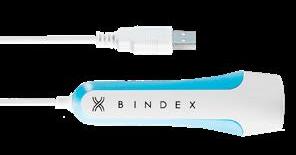
Standard cognitive screening tools like MMSE/ MOCA are exactly that; screening tools. The technology is there to test the patients that fail these screening tools right in your office. Get clinically relevant information about your patients’ brain performance, while generating additional reimbursement for the practice, leading to earlier diagnosis and more accurate referrals.
Aids in clear diagnosis • Strong Reimbursement • Improves Patient Outcomes
• Easy for any staff to perform • Cognitive Testing / Mental Health • Sudomotor Function / Neuropathy • Vestibular Testing / Fall Prevention • Autonomic Function/ Cardiovascular Risk


I-STAT SYSTEM
From Abbott Point of Care
The handheld i-STAT System offers a broad menu of diagnostic tests at the patient’s side in just minutes. With just a few drops of blood, the i-STAT System delivers real time, lab-accurate results for a wide range of tests, including chemistries, blood gas, coagulation, cardiac markers, and more. Minimize delays and wasted time with on-side tests. Easy, intuitive operation.
For intended use and complete product information, visit pointofcare.abbott.

For in vitro diagnostic use only. This material is intended for a U.S. audience only. i-STAT is a trademark of Abbott. Physician Office Resource i-STAT Product Description — US 3064.REV1 08/20 Easy, Integrated
FULL COMPLEMENT OF CLIA-WAIVED BLOOD CHEMISTRY TESTS PICCOLO XPRESS® CHEMISTRY ANALYZER
From Abbott Point of Care
The Piccolo Xpress Chemistry Analyzer provides physician offices with lab-accurate results for a broad range of CLIA-waived general chemistry tests, including metabolic panels, lipids, live, and kidney function, and more with just 100 microliters of blood. Easy to use, the PIccolo Xpress provides results during a patient’s visit, accelerating treatment decisions, increasing efficiency, and supporting patient satisfaction. Automated quality control on every test helps ensure accuracy.
TOXICOLOGY SCREENING SIMPLIFIED ABBOTT’S IMMTOX
270 BENCHTOP ANALYZER NOW WITH 14 ASSAYS
CLIA CATEGORIZED AS MODERATE COMPLEXITY
From Abbott
The ImmTox270 benchtop analyzer offers comprehensive toxicology screening solutions for physician offices, treatment centers and independent laboratories.
Broad test menu with over 20 assays to choose from including 14 that are now available as moderately complex.
With complete laboratory solutions from consultation to licensure, and compliance the Abbott Clinical Laboratory Solutions team has you covered.





and wasted
From Abbott CHEMISTRY

Prescription drug misuse and illicit drug abuse is a growing public health challenge in this country. Building a test profile that covers highly misused drugs has never been so vital. With over 20 relevant assays to choose from Abbott’s suite of Immunalysis reagents allows you to easily screen for relevant substances. Our complete line of assays, calibrators, and controls enables you to implement an efficient drug screening program in office.

From Carolina Liquid Chemistries
A fully-automated, open system, benchtop clinical chemistry analyzer with throughput up to 270 tests/hour, 36 reagent positions, and 30 sample positions. It features a menu of over 60 CLIA moderate complexity assays, including cancer markers, cardiovascular markers, coagulation markers, diabetic markers, inflammatory markers, liver markers, renal/pancreatic markers, sepsis markers, vitamin markers, photometric electrolytes, and drugs of abuse. To learn more, visit https://www.carolinachemistries.com/products/dz-lite-c270-benchtop-chemistry-analyzer/.
From Carolina Liquid Chemistries
When starting a lab, look no further. With a CLIA moderately complex menu of 35 general chemistries and 14 urine drug screens, the EasyRA is well-suited for oncology, rheumatology, and multi-specialty practices needing a benchtop clinical chemistry analyzer. The EasyRA offers photometric throughput of 240+ tests/hr (up to 480 tests/hr with ISE) and STAT samples in under 8 minutes. This all-in-one system is easy to learn and easy to operate.

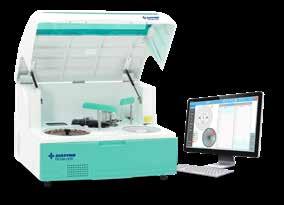


EARLY DETECTION AND MANAGEMENT OF CHRONIC CONDITIONS WITH DCA VANTAGE® AND CLINITEK STATUS®+ ANALYZERS
From Siemens Healthineers SCAN
Siemens Healthineers DCA Vantage® and CLINITEK Status® family of analyzers provide Hemoglobin A1c (HbA1c) and albumin-to-creatinine ratio (ACR) testing at the point of care. Monitor glycemic control in patients with diabetes and screening for kidney disease in patients at-risk, in-office. Enable real-time consultation, eliminating loss to follow-up. Improve the patient experience and overall outcome by providing actionable results in minutes.
CLIA-waived: DCA HbA1c; CLINITEK Microalbumin 2 (ACR) CLIA Moderate Complexity: DCA® Microalbumin/Creatinine (ACR)
From Semler Scientific



QuantaFlo® PAD is an easy to use, accurate, point of care, non-invasive solution that aids in the early detection of peripheral arterial disease (PAD). This FDA cleared device can be administered by a medical aide in less than 5 minutes. As published in the Journal of Vascular Surgery and the American Journal of Preventive Medicine, QuantaFlo detected undiagnosed PAD in 31.6% of patients +65.1 QuantaFlo is portable and integrates with other technologies and platforms. It is ideal for both home and clinic environments.
1. Smolderen KG, Ameli O, Chaisson CE, Heath K, Mena-Hurtado C. Peripheral Artery Disease Screening in the Community and 1-Year Mortality, Cardiovascular Events, and Adverse Limb Events, AJPM Focus (2022), https://doi.org/10.1016/j.focus.2022.100016

From Nova Biomedical
The U.S. FDA has cleared Nova Primary as a blood glucose reference analyzer that fills the need for a new reference analyzer to replace the YSI STAT PLUS 2300 (YSI, Inc., Yellow Springs, OH). Manufacturers of blood glucose measuring devices and clinical diabetes researchers have relied on the YSI 2300 as a reference and correlation analyzer. However, YSI, Inc. no longer supports the analyzer, and its discontinuation has left a critical industry void. With today’s FDA clearance, Nova Primary from Nova Biomedical is now available in the U.S. and worldwide.



BY: ADAM IRVINE – PHYSICIANS OFFICE RESOURCE, STAFF WRITER
The U.S. health care system is at a crossroads. Despite significant advances in medical technology, diagnostics, and therapeutics, the backbone of health care—frontline employees—continues to strain under heavy workloads, staffing shortages, and limited career advancement opportunities. A new survey conducted by The Harris Poll, commissioned by Strategic Education, Inc., highlights a looming crisis that physicians and health care leaders cannot afford to ignore.
Between June 26 and July 21, 2025, the Harris Poll surveyed 1,504 frontline health care employees and 304 employers in the U.S. The results paint a sobering picture: a majority of health care workers are considering leaving their jobs within the next year, and most feel undervalued, underappreciated, and unsupported in their professional growth.
For physicians—many of whom serve as both clinical leaders and mentors within health systems—these findings are particularly relevant. The ability to retain a stable, motivated, and skilled workforce directly impacts patient care, workflow efficiency, and personal well-being. This article unpacks the survey’s findings and explores practical ways physicians and employers can help combat burnout and build resilience within their teams.
Key Findings from the Harris Poll Survey
The survey revealed that 55% of frontline health care employees intend to search for, interview for, or switch jobs in 2026. This turnover intention spans nursing assistants, personal care aides, and even more specialized clinical roles.
For physicians, this has direct implications: higher turnover among nurses and allied health professionals increases workload, complicates care coordination, and contributes to the vicious cycle of burnout.
An overwhelming 84% of employees reported feeling underappreciated at their current organization. Fewer than one-third said they felt “very valued,” and only one in five believed their employer was strongly invested in their long-term career success.
This sense of undervaluation extends beyond paychecks. Many workers cited lack of recognition, limited advancement opportunities, and minimal employer support for education as driving dissatisfaction.
Physicians occupy a unique position at the intersection of leadership, mentorship, and direct care. By fostering recognition, advocating for educational opportunities, addressing workload inefficiencies, and building psychological safety, physicians can play a pivotal role in combating burnout.
Finally, the Harris Poll situates these findings within a larger workforce challenge. The Health Resources and Services Administration (HRSA) projects a shortage of nearly 700,000 health care workers—including physicians, registered nurses, and licensed practical nurses—by 2037. If burnout and turnover are not addressed, this shortage will accelerate, impacting access and quality of care.
As a physician, you may wonder: What can I do about systemic burnout and retention issues? While no single physician can fix national workforce shortages, local leadership and daily clinical culture play an outsized role in shaping staff experience.
• Burnout is contagious: If team members are disengaged or leaving, physicians face more administrative burden and clinical overload.
• Retention improves care quality: A stable workforce ensures smoother handoffs, better patient safety, and stronger care coordination.
• Physicians are leaders: Whether officially or informally, physicians set the tone for recognition, mentorship, and respect within clinical teams.
3. Education and Career Growth Are Retention Levers
More than 60% of respondents said they would be more likely to stay with their current employer if tuition assistance, career development programs, or educational benefits were provided. While employers recognize that lack of growth opportunities drives attrition, fewer are acting decisively to address the gap.
This is an actionable insight: investment in continuing education and career pathways may be one of the most effective tools for reducing turnover.
4. Generational and Role Differences
Generational divides emerged strongly in the data. Younger employees—particularly Gen Z and Millennials—were more likely to consider leaving their jobs and placed higher value on education and growth opportunities.
Additionally, roles like nursing assistants and patient care aides, which already experience high attrition, are at greatest risk. Early-career clinicians in these roles are not only harder to retain but also crucial for maintaining continuity of care.
5. Technology Skills and the Rise of AI
Interestingly, 43% of employees identified artificial intelligence (AI) as the most critical clinical or technical skill they will need in the next five years. However, 42% also expressed concern that AI could replace parts of their role. Employers see AI training as a workforce priority, but many lack adequate resources to implement it.
For physicians, this underscores the importance of staying engaged in conversations about AI adoption—both to ensure patient safety and to support staff through the transition.
By understanding the drivers of dissatisfaction and turnover, physicians can take proactive steps to combat burnout at both the personal and organizational level.
1. Acknowledge and Appreciate Your Team
Small acts of recognition can go a long way. Thanking nurses, aides, and allied health staff publicly during rounds or in team meetings reinforces a culture of respect. Celebrating milestones (certifications, years of service, completed projects) demonstrates that contributions are valued.
Tip for physicians: During handoff or morning huddle, highlight at least one staff member’s effort. Even brief acknowledgments build morale.
2. Support Educational Opportunities
Given that more than 60% of workers cited education benefits as a reason to stay, physicians can advocate within their organizations for tuition reimbursement, professional development funds, or flexible scheduling for continuing education.
Tip for physicians: If you supervise trainees or staff, encourage enrollment in workshops, CME sessions, or certification programs. Offer to mentor or write recommendations when appropriate.
3. Foster Career Development
Many frontline staff see their current role as a stepping stone. By helping team members chart a path forward, physicians can play a vital role in retention.
Tip for physicians: Ask staff during annual reviews or informal check-ins where they see themselves in five years. Offer guidance on next steps and connect them to resources.
4. Address Workload and Efficiency
Physicians are acutely aware of how staffing shortages increase patient volumes and documentation requirements. While systemic reforms are needed, small process improvements can help.
Tip for physicians: Engage staff in workflow redesign. Often, the best solutions come from those closest to the work. Eliminating redundant documentation or reorganizing patient flow can ease burdens.
5. Build Psychological Safety
When staff feel safe to voice concerns, admit mistakes, or suggest changes without fear of blame, morale improves.
Tip for physicians: Model transparency by admitting your own mistakes and inviting feedback. Encourage open dialogue about workload, patient care challenges, and new initiatives.
6. Address Technology Concerns Head-On AI and other digital tools are reshaping clinical practice. Staff need reassurance that these technologies are intended to support—not replace—them.
Tip for physicians: Include your team in conversations about new tools. Demonstrate how AI can reduce administrative burden (e.g., automating documentation) while preserving the irreplaceable human aspects of care.
7. Care for Yourself, Too
Physician burnout is well documented, and leading by example is essential. Prioritizing your own wellness through boundaries, peer support, and healthy habits signals to staff that self-care is not a weakness but a necessity.
Tip for physicians: Share your wellness practices with your team. This normalizes taking breaks, using support resources, and setting realistic expectations.
The Harris Poll findings are a wake-up call. With more than half of frontline health care workers planning to change jobs in the next year, the profession faces a crisis that threatens not only staff morale but also patient outcomes.
Physicians occupy a unique position at the intersection of leadership, mentorship, and direct care. By fostering recognition, advocating for educational opportunities, addressing workload inefficiencies, and building psychological safety, physicians can play a pivotal role in combating burnout.
The projected shortage of 700,000 health care workers by 2037 should not be viewed as inevitable. Instead, it should galvanize the profession to act—locally, in clinics and hospitals, and nationally, in conversations about workforce development and health care reform.
Ultimately, retaining and uplifting the health care workforce is not just an HR initiative—it is a clinical imperative. For physicians, investing in the well-being of colleagues is investing in the well-being of patients.
The Harris Poll underscores what many physicians already sense on the ground: health care workers are burned out, undervalued, and seeking new opportunities. Yet it also highlights solutions—education, recognition, and leadership—that can make a meaningful difference.
By leaning into their role as leaders, physicians can help build resilient teams, mitigate burnout, and contribute to a more sustainable future for the profession.
Turnover intention
Feeling undervalued
Education as a retention lever
Generational divides
AI and technology
Workforce shortage
55% plan to switch jobs in 2026
84% feel underappreciated
60% would stay if tuition assistance offered
Younger workers more likely to leave
43% say AI is key skill; 42% worry about replacement
700,000 projected by 2037
Implication for Physicians
Prepare for instability; foster retention locally
Recognition and respect are critical leadership tools
Advocate for education benefits and mentor staff
Tailor support and mentorship to early-career staff
Reassure, train, and engage staff in AI adoption
Act now to stabilize teams and advocate for system-level reform
From LifeSign
Status Flu A & B is an in vitro rapid qualitative test that detects influenza type A and type B directly from nasal swab, nasopharyngeal swab, and nasopharyngeal aspirate/wash specimens obtained from patients with signs and symptoms of respiratory infection. It is intended to aid in the rapid differential diagnosis of Influenza A and B viral infections.
• CLIA waived *Innovative flip design with onboard sample extraction
• Premeasured developer solution capsule for increased accuracy and ease of use
• Flocked nasal swabs for improved patient comfort and superior specimen collection
From LifeSign



A Rapid Immunoassay for the Simultaneous Direct Detection and Differential Diagnosis of SARS-CoV-2, Influenza Type A and Type B Antigen from Anterior Nasal and Nasopharyngeal swab specimens. Infections with these viruses may present similar symptoms. Can you tell them apart? WE CAN!

BIOFIRE SPOTFIRE
From bioMerieux
bioMérieux knows that an evolving world deserves evolved diagnostics. Our latest innovation, the BIOFIRE® SPOTFIRE® Respiratory Solution, is the first FDA-cleared and CLIA-waived COVID-19 testing solution. The BIOFIRE® SPOTFIRE® System is an easyto-use system that runs the BIOFIRE® SPOTFIRE® Respiratory (R) Panel. Benefits of the SPOTFIRE Respiratory Solution include: 15 respiratory targets on 1 PCR test with results in about 15 minutes; minimal benchtop space with vertical scalability up to four modules; easy to use with an intuitive user interface.


I G H T N O W .
1 O U T O F 3 H A S P A D A N D T H E Y P R O B A B L Y D O N ’ T K N O W I T . A
Healthy Artery
P E R I P H E R A L
Patients with Peripheral Artery Disease (PAD) who may be facing a heart attack, stroke, amputation, or even death within the next 5 years I N T R O D U C I N G
Diabetics Smokers Over age 65

Diseased Artery

Atherosclerosis
(PAD) is an often silent condition where narrowed arteries reduce blood flow to the legs, causing symptoms like leg pain, numbness, and slow-healing wounds.
DON’T LET PAD SNEAK UP ON YOU OR THESE PATIENTS.
50% report no symptoms, while those that do attribute their pain to arthritis or “old age”.

N o n - i n v a s i v e , p a t i e n t - f r i e n d l y t e s t
A C C U R A T E
A c c u r a c y e q u a l o r b e t t e r t h a n D o p p l e r A B I .
U s e f u l f o r d i a b e t i c s w i t h c a l c i f i e d a r t e r i e s
R E I M B U R S A B L E
r .
G r e a t R O I : t h e t y p i c a l i n t e r n i s t h a s 8 0 0 M e d i c a r e p a t i e n t s , p e r A C P
T
l e s s t h a n t w o m o n t h s .
C P T 9 3 9 2 3 ( A B I w / e x e r
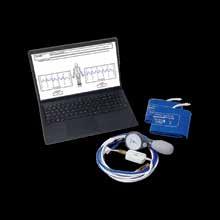

THESE PATIENTS TRUST YOU TO FIND THEIR PAD
before they have a heart attack, stroke, or even die PAD also leads to significant disability and reduced quality of life.


For over 45 years, Newman Medical has been a leader in vascular innovation The ABI-Q system continues that legacy with fast, accurate results you can trust
Scan for more info

From Sekisui Diagnostics
The Acucy™ Influenza A&B Test is for the rapid, qualitative detection of influenza A and B viral nucleoprotein antigens from both nasal and nasopharyngeal swabs. Utilizing the Acucy™ Reader in either the point-ofcare or laboratory setting, workflow flexibility is achieved with both Read Now and Walk Away features. The combination provides clinicians with standardized and definitive result interpretation.


From Sekisui Diagnostics
The Metrix® COVID-19 is a novel technology includes clinical claims for symptomatic and asymptomatic individuals, along with dualsample types for nasal or saliva, allowing for an enhanced point-ofcare testing experience. The reader is compact and robust, it’s ideal for professional use in diverse locations, including clinics and mobile health units. It’s a maintenance free device with no calibration step required.

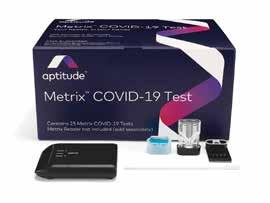
From Sekisui Diagnostics
The OSOM® COVID-19 Antigen Rapid Test is a lateral flow immunoassay that detects the SARS-CoV-2 nucleocapsid protein with a nasal swab in only 15 minutes at the point-of-care. The test is intended to be used by healthcare professionals or operators on patients suspected of COVID-19 within the first 7 days of symptom onset. The clinical performance compares favorably against polymerase chain reaction methodology, with a positive percent agreement of 95.1% and a negative percent agreement of 97%.
OSOM® COVID-19 Antigen Rapid Test has not been FDA cleared or approved. It is authorized by FDA under an EUA for prescription use only. It has been authorized only for the detection of SARS-CoV-2 antigen, not for any other viruses or pathogens and is only authorized for the duration of the declaration that circumstances exist justifying the authorization of emergency use of in vitro diagnostics for detection and/or diagnosis of COVID-19 under Section 564(b)(1) of the Federal Food, Drug, and Cosmetic Act, 21 U.S.C S360bbb-3(b)(1), unless the authorization is terminated or revoked sooner.
5523

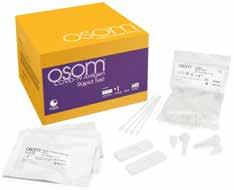
From Sekisui Diagnostics
Test for both high-risk groups, younger children & elderly adults, for severe RSV infection using the OSOM® RSV Test. This test is a CLIA-waived, point-of-care test designed to detect Respiratory Syncytial Virus (RSV) using a painless anterior nasal swab in just 15 minutes. It is suitable for both children aged 6 months to 6 years and adults aged 60 and above, providing healthcare professionals with flexibility in diagnosing patients exhibiting symptoms of respiratory infections.


From Abbott
With reduced budgets, shrinking laboratory space and staffing challenges, many laboratories need a solution that lets them work smarter with less. The CELL-DYN Emerald 22 AL is a full performance, automated optical 5-part differential analyzer that delivers smarter results for small to midsize clinical laboratories.
• Compact Design
• Walkaway Functionality
• Ease Of Use
• Smart Safety Features

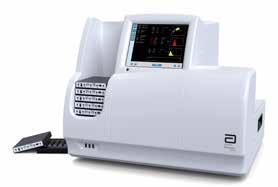
From Sysmex
With its simplified operation, the Sysmex XP-300™ is ideal for clinics and physician office labs. It provides a CBC with 17 different parameters, including a 3-part WBC Differential. The XP-300+M combines the accuracy and reliability of a Sysmex CBC with the agility of Medicus Middleware. Features include EMR connectivity, instrument interfaces and a QC module.


From Sight Diagnostics
OLO® by Sight Diagnostics® is a state-of-the-art benchtop CBC analyzer that leverages AI, spectroscopy, and digital fluorescent microscopy to provide lab-grade results through full blood sample digitization. OLO offers 19 CBC parameters, including a 5-part white blood cell differential and 14 distinct flags. It handles venous and capillary blood samples with a minimum of 27 µL, and is suitable for children as young as three months. OLO’s unique cartridge-based technology, free from liquid reagents, and its internal controls offer easy maintenance, room-temperature storage, reduced operational overhead, and IQCP- eligibility.



MICROS HEMATOLOGY ANALYZER WITH 3-PART DIFFERENTIAL PLUS THE LITEDM
From HORIBA Medical
Is it viral or bacterial? A CBC with 3-part differential can provide the clues to help distinguish between viral and bacterial infections before you decide to treat. The Micros 60 Hematology analyzer provides a CBC with 3-part Diff result in less than 60 seconds using only 10 µL of sample. Connect to the LiteDM Patient Data Management System for an affordable way to consolidate patient results to one report.


From Sysmex
Designed for labs testing up to 25 samples per day, the Sysmex pocH-100i™ has the smallest footprint of any analyzer on the market. The instrument requires only 15uL of whole blood for reporting of 17 clinical parameters, including a 3-part WBC Differential. It is ideal for urgent care, physician office lab, small clinic, or any outpatient setting where a point of care CBC is needed.


Comprehensive toxicology menu now with 14 CLIA 1 categorized moderate complexity assays.


Toxicology screening solutions for physician offices, pain management, treatment centers and laboratories testing 200+ patient samples/mo.
MODERATE COMPLEXITY ASSAYS – FDA 510(K) CLEARED
6-acetylmorphine (6-AM Heroin metabolite)
Amphetamine
Barbiturates
Benzodiazepines
Benzoylecgonine (Cocaine metabolite)
Buprenorphine
Cannabinoids (THC)
1. Clinical Laboratory Improvement Amendments (CLIA) / * SEFRIA Fentanyl

EDDP (Methadone metabolite)
Fentanyl*
Methamphetamine
Opiates
Oxycodone
Phencyclidine (PCP)
Tramadol
Scan this QR code to view the ImmTox™ 270 product video
From Medicus LIS

If you are considering in-house lab testing, including Covid-19 testing and required reporting to state agencies, connecting Lab to LIS and EHR makes the process of test orders to completed results much easier. Providers receive test results posted to patient charts in real-time, expediting patient care, saving time, money and even preparing for lab test reimbursement goals. Link Your Lab with Medicus LIS today! Contact us: 888-643-8081 sales@medicuslis.com
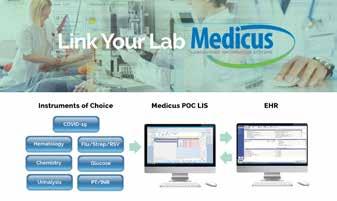
From MyInspection
• Meets all CLIA compliance requirements
• No interpretation of CLIA regulations required – includes all policies, procedures, electronic fillable forms stored systematically for easy retrieval
• Remote access – manage individual or multiple labs remotely from your PC, tablet or phone
• Easy to audit and document changes with electronic signatures and dating
• Expert guidance from licensure to your customized documentation system
• Be, stay compliant and inspection ready – reduce time, cost, and stress
From Semler Scientific



QuantaFlo® PAD is an easy to use, accurate, point of care, non-invasive solution that aids in the early detection of peripheral arterial disease (PAD). This FDA cleared device can be administered by a medical aide in less than 5 minutes. As published in the Journal of Vascular Surgery and the American Journal of Preventive Medicine, QuantaFlo detected undiagnosed PAD in 31.6% of patients +65.1 QuantaFlo is portable and integrates with other technologies and platforms. It is ideal for both home and clinic environments.
1. Smolderen KG, Ameli O, Chaisson CE, Heath K, Mena-Hurtado C. Peripheral Artery Disease Screening in the Community and 1-Year Mortality, Cardiovascular Events, and Adverse Limb Events, AJPM Focus (2022), https://doi.org/10.1016/j.focus.2022.100016



PAD TESTING SYSTEMS IDEAL FOR PRIMARY CARE TO VASCULAR SPECIALISTS
from Newman Medical
Your Patients Trust YOU To Find Their Peripheral Artery Disease
• High-risk patients include those over 65, diabetics, and smokers.
• If left untreated, 25% of patients with PAD will experience a heart attack or stroke within 5 years.
• PAD symptoms are often mistaken for arthritis or old age.
The simpleABI Cuff-Link System is Easy to Learn and Use.
• With a push-button remote, automatic calculations, and waveforms, it’s incredibly user-friendly.
• Reports are straightforward to save and share since the system is PC-based.
Outstanding Value and Reimbursements
• The system pays for itself in less than a year with just one test per week.
• Medicare reimbursements vary by exam and location, averaging from $91 to $174.
TOXICOLOGY SCREENING SIMPLIFIED ABBOTT’S IMMTOX 270 BENCHTOP ANALYZER NOW WITH 14 ASSAYS
CLIA CATEGORIZED AS MODERATE COMPLEXITY
From Abbott
The ImmTox270 benchtop analyzer offers comprehensive toxicology screening solutions for physician offices, treatment centers and independent laboratories.
Broad test menu with over 20 assays to choose from including 14 that are now available as moderately complex.
With complete laboratory solutions from consultation to licensure, and compliance the Abbott Clinical Laboratory Solutions team has you covered.




SOFIA® 2 FLUORESCENT IMMUNOASSAY ANALYZER AND RAPID DIAGNOSTIC TEST KITS
From QuidelOrtho

Sofia® 2 Fluorescent Immunoassay Analyzer and Rapid Diagnostic Test Kits Sofia 2 takes rapid testing to a new level. Proven lateral-flow technology and advanced fluorescent chemistry are all integrated into this small benchtop analyzer which can be used in any point-of-care setting. Sofia 2 kits are easy to use and adaptable to any healthcare setting. Excellent performance, objectivity, quality control, LIS capabilities, and an expanding test menu make Sofia 2 the perfect solution for the physician’s office laboratory.
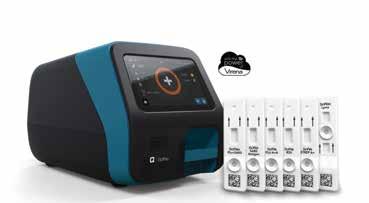

Whether you're craving pristine beaches or vibrant cities, these nine must-visit destinations around the world promise stunning scenery, rich culture, and unforgettable adventures for every type of traveler.
Tucked away on a private stretch of white sand and palm trees, you will find the iconic Harbour Village Beach Club. An oasis beloved by sun lovers, scuba divers, and seafarers alike. Our boutique Bonaire retreat captures the breezy, barefoot elegance of the Dutch Caribbean, consistently earning the title of “Bonaire's leading hotel” in the World Travel Awards.

SCAN TO LEARN MORE


Deeply rooted in the land, the history, and the layered richness of Oahu, at Turtle Bay you’ll find an authentic connection to a place of uncommon natural splendor and the warm, welcoming community within it. Where your days are filled with constant discovery and moments that touch your soul, allowing you to explore the uncommon depths of this remarkable coast.

SCAN TO LEARN MORE
Discover an elevated escape with the perfect balance of fun and relaxation at our AAA Five Diamond, luxury Orlando Resort. Splash around with the family at Explorer Island water park, or unwind beneath swaying palms at Oasis adult-only pool while we entertain your young ones at our complimentary kids camp. Treat yourself to a soothing, post-park massage at The Spa, then toast to the nightly Walt Disney World® fireworks views over dinner at our Michelin-starred rooftop steakhouse Capa.


SCAN TO LEARN MORE

Secrets Cap Cana Resort & Spa is a sophisticated, adults-only hideaway located in the exclusive gated community of Cap Cana Facing the clear Caribbean Sea along the white sand of the exclusive Juanillo Beach. Secrets Cap Cana Resort & Spa is proud to support the Punta Cana Promise as part of the ongoing commitment to ensure that guests will continue to receive the highest levels of service and security they have come to know and expect from Secrets Cap Cana. The Punta Cana Promise reaffirms the commitment to a set of security standards and safety guidelines in one of the top travel destinations in the Dominican Republic.

SCAN TO LEARN MORE
Balboa Bay Resort is Newport Beach’s premier waterfront retreat offering stunning bay views and sunsets over Balboa Bay’s harbor. It is the #1 Resort in Newport Beach per U.S. News & World Report, and it is rated as a Forbes Four-Star and AAA Four-Diamond resort.



At Desolation Hotel, modern conveniences and eco-luxury commingle with Japanese tranquility and Scandinavian design. Our one-of-a-kind South Lake Tahoe experience inspires adventure and invites tranquility, providing the right space to recharge your battery. Balancing reverence for the past with appreciation for the present, Desolation Hotel nods to the simple days of yesteryear, while modern technology serves as a quiet backbone to the entire resort experience.

Situated within the new 56-acre Water Street Tampa neighborhood, the hotel is home to 172 guest rooms and suites and 7 food and beverage venues, including a signature restaurant, rooftop bar and terrace. The property features a 204 sqm Penthouse Suite, expansive spa, fitness center and over 550 sqm of flexible meeting and events space. Bringing some of the world’s best talents together into one project, the property is designed by acclaimed New York-based architecture practice Morris Adjmi in collaboration with Florida-based firm Nichols Brosch Wurst Wolfe & Associates; with interiors designed by the renowned Roman & Williams, and the whole project underpinned by the creative vision of Ian Schrager and Ian Schrager Company.



Welcome to Four Seasons Hotel Nashville, a luxury hotel located in the heart of downtown’s vibrant SoBro neighborhood. This new social hub is just steps away from the city's iconic music, sports, and entertainment venues. Experience the rhythm of our lively restaurants and event spaces, the tranquility of our Spa, and the stunning views from our rooftop pool overlooking the Cumberland River and Riverfront Park. With the unmatched service of Four Seasons and warm Southern hospitality, we’ll inspire an authentic experience of Music City.

SCAN TO LEARN MORE
As one of the only non-gaming and non-smoking hotels on The Strip, Four Seasons Hotel Las Vegas is a unique oasis in the heart of the action-packed sports and entertainment capital of the world. Offering Five Diamond luxury accommodations, acclaimed dining and a Forbes Five-Star spa, Four Seasons offers the best of both worlds: a resort retreat amid the famous energy of Las Vegas.


SCAN TO LEARN MORE


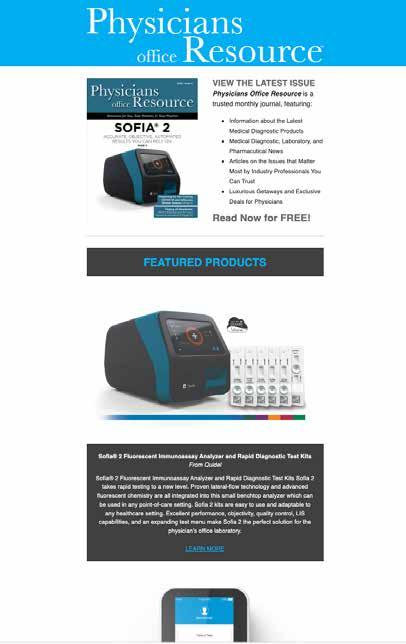


OSOM® ULTRA STREP A TEST
From Sekisui Diagnostics
The OSOM® Ultra Strep A test is a color immunochromatographic assay intended for the qualitative detection of Group A Streptococcus antigen directly from throat swab specimens. Shown to be not statistically different than single swab culture. Sensitivity 95.7% and 100% Specificity. Includes two additional test sticks for External QC. CLIA Waived.
OSOM® BVBLUE®
From Sekisui Diagnostics
The OSOM® BVBLUE® detects elevated vaginal fluid sialidase activity, an enzyme produced by bacterial pathogens associated with bacterial vaginosis including Gardnerella, Bacteroides, Prevotella and Mobiluncus. OSOM® BVBLUE® is more sensitive than Amsel criteria providing physicians with a more accurate diagnosis to treat and minimize serious health consequences such as early spontaneous preterm births and miscarriage.
OSOM® TRICHOMONAS RAPID TEST
From Sekisui Diagnostics
The OSOM® Trichomonas Rapid Test is intended for the qualitative detection of Trichomonas vaginalis antigens from vaginal swabs or from the saline solution. The OSOM® Trichomonas Rapid Test is a CLIA-waived rapid test available today. OSOM® Trichomonas is more sensitive than wet mount due to the assay being able to detect viable and non-viable organisms which offers significant benefits to the patient and clinician alike.





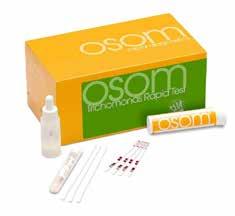
From Sekisui Diagnostics
The OSOM® Ultra hCG Combo test is a simple immunoassay for the qualitative detection of human chorionic gonadotropin (hCG) in serum or urine for the early confirmation of pregnancy. Internal studies have confirmed that the OSOM® Ultra hCG Combo test does not have a false negative result from hCG variants providing physicians with a higher level of confidence.

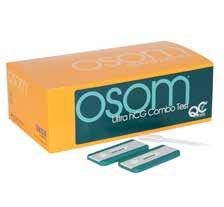


BY: MATT BAKER, STAFF WRITER PHYSICIANS OFFICE RESOURCE
Each fall and winter, respiratory viruses place significant demands on outpatient medicine. Primary care physicians, pediatricians, and urgent care providers are often the first point of contact for patients experiencing cough, fever, congestion, and other respiratory symptoms. In 2025, the convergence of influenza, COVID-19, RSV, and other viral pathogens is expected to once again increase patient load, stretch staff capacity, and test the preparedness of outpatient clinics.
By acting now, practices can position themselves to manage surges efficiently while maintaining high-quality care and protecting staff well-being. This article outlines evidence-based and practical steps to prepare your team, office, and workflows for the upcoming respiratory illness season.
One of the most predictable aspects of respiratory illness season is unpredictability—some years see moderate case counts while others overwhelm clinics. A proactive staffing and supply plan reduces bottlenecks when demand spikes.
• Cross-training: Medical assistants may need to help with swabbing, nurses may rotate into triage roles, and front desk staff may support patient education or vaccine scheduling. Investing in cross-training now ensures flexibility later.
• Contingency planning: Develop a system for temporary coverage in the event of staff illness. Consider part-time, per diem, or retired clinicians who can step in during peak demand.
• Flex scheduling: Evening or weekend hours can help decompress high-volume weekdays and improve patient satisfaction, particularly in urgent care.
• Diagnostic tests: Stock rapid antigen kits for quick triage and molecular assays for confirmatory diagnosis. Multiplex panels (COVID/Flu/RSV) may be especially useful for pediatric populations.
• PPE: Even if mandates fluctuate, respiratory protection remains important. Keep a reserve of N95 or KN95 masks, gloves, gowns, and eye protection.
• Vaccines: Ensure your cold storage units have adequate capacity. Verify calibration and temperature monitoring systems to prevent spoilage.
TIP: Track usage patterns from prior years to better estimate order volumes. For example, if your pediatric office doubled flu vaccine doses last year, consider increasing orders early this season.
Rapid, accurate diagnosis benefits both patient care and clinic efficiency.
• Point-of-care testing (POCT) reduces delays in treatment
decisions and minimizes unnecessary antibiotics. A child with confirmed influenza can start oseltamivir promptly, while a patient with negative results may avoid needless antibiotic exposure.
• Multiplex testing is increasingly important as symptoms overlap. In one swab, clinicians can distinguish among COVID-19, influenza A/B, and RSV, guiding isolation, treatment, and patient counseling.
• Triage algorithms help staff decide when POCT is sufficient versus when PCR confirmation or referral is warranted. Create clear flowcharts visible to both clinicians and support staff.
Case example: A 3-year-old with cough and fever presents at your office. A rapid multiplex test confirms RSV. Instead of prescribing antibiotics or escalating unnecessarily, your team provides supportive care instructions and educates the family about red-flag symptoms. This reduces downstream costs and builds trust with parents.
3. Vaccination Strategies
Vaccines remain the strongest preventive measure against severe respiratory disease.
Influenza
CDC recommends vaccination for everyone over six months of age, ideally before the end of October. Encourage patients not to delay, even if flu activity appears low.
High-dose and adjuvanted formulations should be prioritized for older adults.
COVID-19
Updated boosters targeting current variants continue to be essential. Primary care physicians are key in addressing lingering vaccine fatigue and misinformation.
Reassure patients about safety profiles and emphasize protection against hospitalization and long COVID.
RSV
Pediatrics: Nirsevimab, a monoclonal antibody, is now available to protect infants under eight months, and certain high-risk toddlers.
Adults: Recently approved vaccines for older adults should be incorporated into fall immunization planning, especially for those with COPD, heart disease, or diabetes.
Implementation Tips
Use standing orders so nurses can administer vaccines without requiring physician approval for each patient.
Offer co-administration (flu and COVID boosters at the same visit).
Track uptake rates by age group to identify under-vaccinated populations in your practice.
4. Workflow and Infection Control
Maintaining safe and efficient office flow is essential when contagious illnesses peak.
• Cohorting patients: Designate specific exam rooms or time blocks for sick visits to limit cross-contamination.
• Telehealth: Retain telemedicine as a tool for mild symptom checks, prescription renewals, or post-illness clearance notes. It helps reduce waiting room congestion.
• Infection prevention: Retrain staff on proper donning and doffing of PPE, surface disinfection, and handling of contaminated waste.
• Air quality: Portable HEPA filters or upgraded HVAC systems can lower airborne viral load, particularly in pediatric offices where masking compliance may be variable.
5. Patient Education and Communication
Clear, proactive messaging empowers patients and reduces strain on staff.
Topics to Emphasize
• Prevention: Hand hygiene, proper cough etiquette, and masking in crowded settings remain effective.
• When to seek care: Provide criteria for home care versus urgent evaluation (e.g., shortness of breath, dehydration, persistent high fever).
• Return-to-school/work guidance: Parents especially appreciate written instructions on when children are safe to return.
Communication Channels
• Digital: Use EHR messaging, text alerts, and practice websites to update patients on vaccine availability or testing policies.
• Printed handouts: Distribute educational sheets at check-in or discharge.
• Community engagement: Partner with schools, daycares, and senior centers to share timely information.
Example: A pediatric practice can post weekly updates on flu vaccine availability on its Facebook page, reducing phone call volume to the front desk.
6. Clinical Management and Therapeutics
Beyond prevention, clinicians must be ready with evidence-based management strategies.
Antivirals
• Influenza: Oseltamivir remains first-line for high-risk patients; baloxavir offers single-dose convenience. Initiate therapy within 48 hours of symptom onset for greatest benefit.
• COVID-19: Nirmatrelvir/ritonavir (Paxlovid) is highly effective but requires screening for drug-drug interactions. Remdesivir remains an option for certain high-risk outpatients.
• RSV: Supportive care remains the standard, though hospitalization thresholds differ for infants and older adults.
Protocol Development
• Create standardized treatment pathways for common clinical scenarios. For instance:
· High-risk older adult with flu-like symptoms → rapid flu test → if positive, initiate antiviral immediately.
· COVID-positive patient with mild symptoms but CKD → consult protocol for Paxlovid contraindications and consider alternatives.
Antibiotic Stewardship
• Reinforce guidelines for avoiding unnecessary antibiotic prescriptions. Overprescribing increases resistance and offers little benefit for viral illness.
Accurate data tracking supports public health surveillance and helps clinics anticipate surges.
• Ensure your EHR is configured for automated reporting of COVID-19, flu, and RSV testing where required.
• Assign a staff lead to monitor state and local health department updates for outbreak alerts.
• Consider participating in syndromic surveillance net works, which can offer early warnings of community spread.
High patient volumes and long seasons can wear down even the most dedicated teams. Sustaining morale and resilience is critical.
• Regular check-ins: Short daily huddles keep communication open and allow staff to voice concerns.
• Mental health resources: Encourage use of employee assistance programs, peer support, or wellness apps.
• Recognition: Small gestures—lunch for the team, public acknowledgment of extra effort—help maintain morale.
• Break coverage: Ensure staff can take true breaks to recharge, especially during double shifts.
The respiratory illness season is inevitable, but its impact on your practice can be managed with preparation. By strengthening staffing plans, securing supplies, implementing efficient testing, promoting vaccinations, and communicating effectively with patients, outpatient practices can stay ahead of the surge.
Primary care physicians, pediatricians, and urgent care providers are the backbone of community respiratory illness response. With thoughtful preparation, your practice can continue to deliver safe, timely, and effective care—even when waiting rooms fill and phone lines buzz. Ultimately, preparation is not just about logistics—it’s about protecting your patients, your staff, and the trust your community places in you.











Respiratory season can pose a real threat to your patients, especially the elderly. Fast, accurate diagnosis and treatment is one way to protect them and get them back to doing what they love. Having the right diagnostics in your office can help you deliver a higher level of patient satisfaction and improve efficiency.
Our product portfolio includes high-quality, point-of-care molecular and antigen tests for diagnosing respiratory illnesses.
We make diagnostics that matter because we believe each test represents the health and well-being of a real person.
